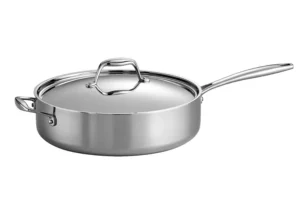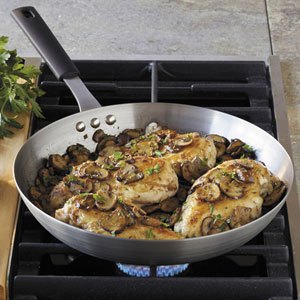We independently review everything we recommend. When you buy through our links, we may earn a commission.
Fry Pan, Skillet Vs Saute Pan: Whats the difference?
Take a look at your cookware. You likely see plenty of pans in which you sauté vegetables, fry an egg, or cook a breakfast skillet. They probably look very similar, with a shallow basin and flat bottom.

However, though they are often mistaken for each other, fry pans, skillets, and sauté pans are each slightly different and optimized for cooking certain foods. So, what are the differences? Glad you asked!
The key differences
The first place to look is the shape of your pan. You have pans with straight sides that are perpendicular to the bottom and you have pans with sloped sides. Those straight-siders are sauté pans. Sauté is French for “to jump”—exactly what oil does in these pans. The taller sides contain your food and fat. What’s more, sauté pans generally come with lids that fit snugly on top of the straight sides. Skillets and fry pans, on the other hand, have sloped sides that make flipping your ingredients or cooking confit easier.

The shape of the sides impacts more than the height of your pan, it also affects the cooking surface. Pans’ diameters are measured from edge to edge, which means fry pans have a larger diameter than a sauté pan, thanks to the sloped sides. A 12-inch fry pan may look bigger than a 12-inch sauté pan, but they have the same cooking area.
Volume
Although sauté pans have a smaller surface area than skillets or fry pans, they can carry more volume. Their shape makes them ideal for holding liquid. Additionally, if you ever need to transfer your pan from the stove top to the oven, sauté pans are the way to go—their high sides help prevent spills as you move them.
Handling
As noted already, skillets and fry pans are perfect for flipping or shaking your food. Their sloped sides act as a surface to toss ingredients against. Furthermore, they tend to be lighter in weight than sauté pans and so are designed for movement. Sauté pans are heavier. Their shape and weight, and the addition of a lid, also make them best for simmering and searing.
Fry pan vs. skillet
While a sauté pan is the easiest to differentiate from its pan cousins because of its shape, fry pans and skillets are somewhat different as well, though more interchangeable. The former tends to be made with stainless steel or to have nonstick coating. Skillets are generally made of cast iron, have sloped sides, and are shallower than sauté pans. Fry pans, with their lighter weight, can come with lids, just like sauté pans do.
Exceptions
Of course these are general guidelines and there are always exceptions. One notable exception is CHEFS’ Electric Skillet, which comes in both stainless steel and ceramic nonstick versions.
Which should you use?

Now that you know the differences, you can use the right pan for your recipe. Because each pan has its own merits and benefits, they all have a place in your kitchen.
- Sauté pan: The shape of this pan makes it ideal for searing. You don’t have to toss the meat, so you can let it sit in your sauté pan and flip it with tongs. Additionally, cook any food in this type of pan that you want to, at some point, move to the oven. Sauté pans are also ideal for making a sauce. For instance, add flour to the meat juice leftover to create a gravy. The sauté pan’s tall sides contain liquid well.
- Skillet/Fry pan: While skillets are often made of cast iron (though not always), both pans are good for frying most foods. However, don’t cook acidic ingredients, such as tomatoes, in a cast iron skillet since cast iron reacts with acidic foods, causing the material to degenerate.
